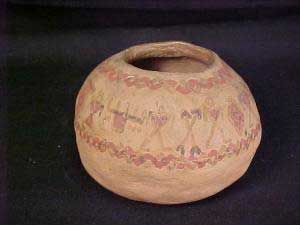When Europeans and Africans began arriving in what
is now Virginia, they met Indian people from three linguistic
backgrounds. Most of the coastal plain was inhabited by an
Algonquian empire, today collectively known as Powhatan. The
southwestern coastal plain was occupied by Iroquoians, the Nottoways
and Meherrins. The piedmont was home to two Siouan confederacies,
the Monacans and the Mannahoacs. The Virginia mountains, by A.D.
1600, were hunting territory to many peoples and home to few.
The first permanent European settlement, in 1607, was English.
English colonies were agricultural, having little of the French
emphasis on trading or the Spanish one on mining, militarism and
missionizing. The Virginia Indians were therefore soon embroiled in
a competition for space -- one which they lost gradually as more
Englishmen and Africans came. Although there was fighting at times,
the Indians were not so much conquered militarily as as they were
flooded out.
The process occurred first on the coastal plain, where by 1700 there
were only a handful of tiny Algonquian-speaking islands, and one
Iroquoian one, left in a sea of English-speakers. By 1790 only four
Algonquian reservations (Pamunkey, Mattaponi, Nansemond, and
Gingaskin) and an Iroquoian one (Nottoway) were left. Some of the
tribes that lost reservations went on living together nearby,
becoming ancestors of the modern "citizen" tribes (Chickahominy,
Upper Mattaponi, Rappahannock); others dispersed. In the piedmont,
the Siouan tribes saw the handwriting on the wall and withdrew
southward, sometimes returning and then leaving again. Non-Indians
poured freely into their territory. After the Tuscarora War
(1715-16), some Siouans went north with the Tuscarora. Others
drifted back into Virginia, less as tribes than as families, and
settled in the piedmont and along the Blue Ridge. The population of
all of these groups was too small to maintain their languages, even
on the reservations. The native tongues of Virginia were practically
dead by 1800, none of them having been adequately recorded. The
Indians' traditional cultures changed slowly and without direct
interference (the Virginia English were not great missionizers), and
by 1800 even the reservation people were much Anglicized.
Virginia was a "slave" state before the Civil War and a "Jim Crow"
state after it. Indian tribes were neither "superior" whites nor
"subservient" blacks. Their anomalous position kept them under
continual fire until the Civil Rights Era. Everyone seemed to want
them to disappear. In 1792 the Nansemonds sold their reservation.
The Nottoway and Gingaskin reservations were terminated soon after
-- the Gingaskin being the first true termination in the U.S.
(1813). The Pamunkeys/Mattaponis nearly lost their land and tribal
status in the 1840's. The "citizen" Indians lay low for most of the
period. When anthropologists James Mooney and Frank Speck began
working in Virginia (1890's-1920's), some groups reconstituted
themselves in a way that was legal and hard for hostile non-Indians
to obstruct: they organized as chartered corporations (Chickahominy,
Upper Mattaponi, Rappahannock).
The two surviving reservations have always had recognition from the
state, though not the federal government since their treaty (dated
1677) is with the Colony of Virginia. They have mixed feelings about
federal recognition now that they can get it. The incorporated
"citizen" tribes won through to state recognition in 1983, inspiring
the Nansemond families to organize and gain recognition the next
year. The Siouan-descended Amherst County Indians followed suit,
though more slowly, taking the name of some of their probable
ancestors, the Monacan. However, further advance to federal
recognition is problematic for the "citizen" groups, due to the
scarcity of records kept about non-reservation Indians and the
burning of many Virginia archives during the Civil War. Meanwhile,
all the groups benefit from the federal funds for education and
community development that are available today. They are more
prosperous now than they have been since the aliens came.
 ClayHound Web
- Pamunkey
Pottery
ClayHound Web
- Pamunkey
Pottery 2.
2.
